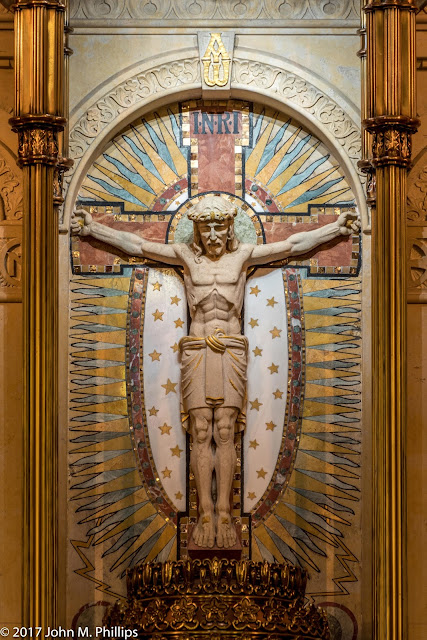Day 1: Library Books.
I felt that I should get going with the challenge, even though the weather was bad, so the easiest subject at hand was my personal library. I chose two shelves of books on science.
I picked these because they were easy to set up with my camera and tripod and because I wanted to express the fact that science is important to me. I spend a fair amount of time in my library, not always reading but always comforted by my books, which I consider friends, many of which I have owned for well over 50 years.
Day 2: Fence.
I did get out the next day, visiting a local park, Doctors Park, on the shores of Lake Michigan in Fox Point, a neighboring community. I had not been to Doctors Park for a couple of years, and, though the weather was cold and windy, I found a number of photo opportunities.
I thought this shot worked best. I softened the photo a bit, which I thought helped the shot's overall feel.
Day 3: Stained Glass Window.
This was a "cheat" of sorts. I'm not sure what the unwritten rules of this challenge were, but this shot was actually borrowed from a September shoot I did of a church in Milwaukee. I did think the shot was representative of what I am interested in photographically. That's my excuse, anyway.
I thought what made this shot was not the actual window but the lighting underneath the gothic arch.
Day 4: Manhole Cover.
The following day was cold and rainy, typical for Milwaukee this time of year. Even so, I found the opportunities interesting. My thought was to photograph one of the rectangular metal plates with raised bumps that one finds wherever a sidewalk slopes down to match the level of a cross street or driveway. And I did take a few shots of one of those, but I chose this shot for how it revealed the wet surface.
Day 5: Farm Window.
I knew that I wanted to return to an abandoned farm a few miles from our home that I had shot many times in the past. And I had this particular window in mind because of the distortion in the shape of the window relative to the frame in which it is situated.
Initially I took a shot of the window from the outside. The photo did a great job of showing how the window had turned into a parallelogram, but it had no character because of the bright sun shining directly on the window. The breakthrough was to move inside the barn and to shoot out. My regret is that I should have centered the house better in the frame so that there was sky showing above the roof of the house. Next time.
Day 6: Basilica Steps.
This is another "cheat." This was actually shot at the Basilica of the National Shrine of the Immaculate Conception in Washington D.C., where we were visiting our daughter in September. And the shot wasn't among the ones I was looking to take.
The basilica was actually something of a disappointment as it was too new and just a bit too gaudy. But this shot was just the reverse of gaudy: It was all about geometric order. It did garner a lot of comment on the challenge when I posted it.
Day 7: Library Atrium.
Milwaukee's central library is a favorite venue of mine, and this is a shot I have done a number of times before. But I didn't cheat for this shot. Rather, I did return to the library for this shot.
I used my newish Tamron 15-30 mm zoom lens and was really happy with the shot overall. In the past for this type of shot I have placed the camera on the floor pointing up and used a remote to trigger the shutter. But here I simply stood in the center of the atrium and shot up handheld. I was impressed with the lens's ability to eliminate camera shake.
John
































